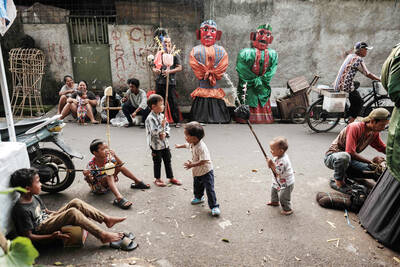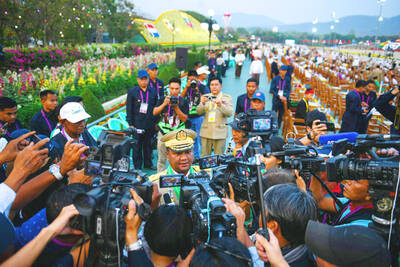Lonnie Thompson spent years preparing for his expedition to the remote, mist-shrouded mountains of eastern Indonesia, hoping to chronicle the affect of global warming on the last remaining glacier in the Pacific. He’s worried he got there too late.
Even as he pitched his tent on top of Puncak Jaya, the ice was melting beneath him.
The 4,884m high glacier was pounded by rain every afternoon during the team’s 13-day trip, something the US scientist has never encountered in three decades of drilling ice cores. He lay awake at night listening to the water gushing beneath him.
By the time they were ready to head home, ice around their sheltered campsite had melted a staggering 30cm.
“These glaciers are dying,” said Thompson, one of the world’s most accomplished glaciologists. “Before I was thinking they had a few decades, but now I’d say we’re looking at years.”
Thompson has led 57 such expeditions in 16 countries around the planet, from China to Peru.
But for him, the Papuan glaciers, because they lie along the fringe of the world’s warmest ocean and could provide clues about regional weather patterns, were an unexplored “missing link.”
It is this region that generates El Nino disturbances and influences climate from India’s monsoons to the Amazon’s droughts.
As such, it is one of the only “archives” about the story of the equatorial phenomenon, said Michael Prentice of the Indiana Geological Survey, who has long been interested in the area. It could also point to what lies ahead for billions of people in Asia.
The ice that covered much of Papua thousands of years ago is today just 2km² wide and 30m deep. Deep crevasses crisscross the dirty ice.
The mountain has lost about 80 percent of its ice since 1936 — two-thirds of that since the last scientific expedition in the early 1970s.
Thompson says he thinks temperatures are rising twice as fast in high altitudes as at the Earth’s surface, which, if true, could have broad implications on people who depend on glaciers for water during the dry season, such as in the Himalayas.
Glaciers worldwide are in retreat, with major losses already seen across much of Alaska, the Alps, the Andes and numerous other ranges. What makes Puncak Jaya different, aside from its location in the Pacific, is just how little is known about it.
Research permits to work in Papua are difficult to obtain, in part because Indonesia’s government is hugely sensitive to the region’s long-simmering insurgency.
Foreign journalists are barred and humanitarian groups are restricted.
It is also one of the most isolated corners of the sprawling archipelagic nation.
The US mining company Freeport-McMoRan, operating nearby, helped airlift the team to Puncak Jaya’s heights by helicopter, along with 4 tonnes of equipment — from electromechanical and thermal drill systems, to radars needed to map the underlying rock, said one of its employees, Scott Hanna.
There was a winch and cables, high-altitude camping gear and boxes to preserve ice samples, which will eventually join more than 60,000m of tropical cores being kept in cold storage in Columbus, Ohio. There, glaciologists will help analyze the ice layer by layer through centuries past.
Flecks of dust, falling seasonally, enable them to count down the years, much like tree rings. Isotopes of oxygen, in minute air bubbles trapped in the ice, vary with temperature helping researchers understand how ancient weather shifted.
“I just hope we weren’t too late,” said Thompson, 62, adding that in addition to melting from the top, water likely seeped in to the base of the glacier, leaving them with limited records from a section of time.
“But still, the have horizontal layers all the way through, so I think we were able to salvage at least a little bit of the climate history,” said Thompson of Ohio State University, who co-coordinated the expedition with Dwi Susanto of Columbia University.
Among other things, the team expects to find volcanic ash from past eruptions — the 1883 blast of Krakatau and Tambora in 1815 should help serve as timelines — soot from wildfires, pollen, plant debris and maybe even frozen animals.

In the sweltering streets of Jakarta, buskers carry towering, hollow puppets and pass around a bucket for donations. Now, they fear becoming outlaws. City authorities said they would crack down on use of the sacred ondel-ondel puppets, which can stand as tall as a truck, and they are drafting legislation to remove what they view as a street nuisance. Performances featuring the puppets — originally used by Jakarta’s Betawi people to ward off evil spirits — would be allowed only at set events. The ban could leave many ondel-ondel buskers in Jakarta jobless. “I am confused and anxious. I fear getting raided or even

Eleven people, including a former minister, were arrested in Serbia on Friday over a train station disaster in which 16 people died. The concrete canopy of the newly renovated station in the northern city of Novi Sad collapsed on Nov. 1, 2024 in a disaster widely blamed on corruption and poor oversight. It sparked a wave of student-led protests and led to the resignation of then-Serbian prime minister Milos Vucevic and the fall of his government. The public prosecutor’s office in Novi Sad opened an investigation into the accident and deaths. In February, the public prosecutor’s office for organized crime opened another probe into

RISING RACISM: A Japanese group called on China to assure safety in the country, while the Chinese embassy in Tokyo urged action against a ‘surge in xenophobia’ A Japanese woman living in China was attacked and injured by a man in a subway station in Suzhou, China, Japanese media said, hours after two Chinese men were seriously injured in violence in Tokyo. The attacks on Thursday raised concern about xenophobic sentiment in China and Japan that have been blamed for assaults in both countries. It was the third attack involving Japanese living in China since last year. In the two previous cases in China, Chinese authorities have insisted they were isolated incidents. Japanese broadcaster NHK did not identify the woman injured in Suzhou by name, but, citing the Japanese

RESTRUCTURE: Myanmar’s military has ended emergency rule and announced plans for elections in December, but critics said the move aims to entrench junta control Myanmar’s military government announced on Thursday that it was ending the state of emergency declared after it seized power in 2021 and would restructure administrative bodies to prepare for the new election at the end of the year. However, the polls planned for an unspecified date in December face serious obstacles, including a civil war raging over most of the country and pledges by opponents of the military rule to derail the election because they believe it can be neither free nor fair. Under the restructuring, Myanmar’s junta chief Min Aung Hlaing is giving up two posts, but would stay at the